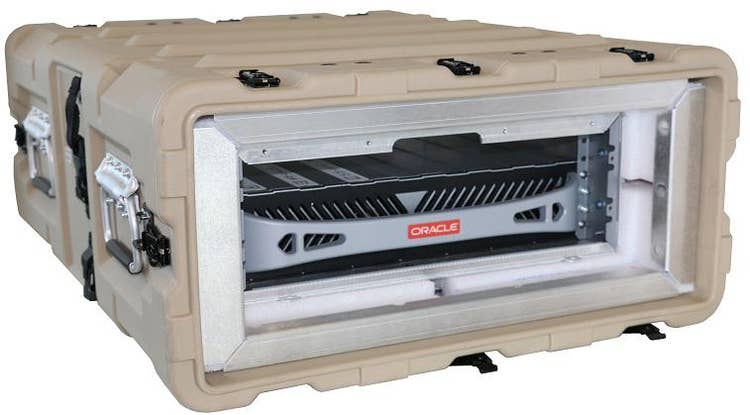Oracle Roving Edge Infrastructure: Bringing The Oracle Cloud To The Edge
“We are delivering a completely disconnected device. We can load the customer application, such as a machine learning model for use with facial recognition or vehicle identification, for instance. The big public cloud providers have done a great job with scale-out and containers. But the answer for scale-up is to connect the application to the cloud,” says Ross Brown, vice president of product marketing for Oracle Cloud infrastructure.

Oracle on Tuesday moved to bring its core cloud infrastructure capabilities to the edge with the introduction of Oracle Roving Edge Infrastructure, a new ruggedized, pre-configured edge device that can be deployed where needed to operate clients’ applications and workloads in the field.
Oracle Roving Edge Infrastructure is configured with customers’ applications before shipping to the field where they are used as needed, with customers paying a fixed $160 per day of usage, said Ross Brown, vice president of product marketing for Oracle Cloud infrastructure.
“This roving edge device is unlike any others available,” Brown told CRN. “It’s not a data transfer device or a tethered device. We are delivering a completely disconnected device. We can load the customer application, such as a machine learning model for use with facial recognition or vehicle identification, for instance. The big public cloud providers have done a great job with scale-out and containers. But the answer for scale-up is to connect the application to the cloud.”
[Related: 10 Future Cloud Computing Trends To Watch In 2021]
The Oracle Roving Edge Infrastructure device is the latest in a series of infrastructure products that make up Oracle’s hybrid cloud portfolio, Brown said.
Oracle, which recently moved its headquarters to Austin, Texas, offers the Oracle Cloud, a public cloud service that currently has 29 live regions, including six that are interconnected with the Microsoft Azure cloud, with another nine regions planned, he said.
On the hybrid cloud side, Oracle offers the Oracle Dedicated Region Cloud@Customer, which enables customers to run all their IT services on a single-tenant cloud infrastructure; Oracle Exadata Cloud@Customer, which delivers high-performance Exadata Cloud Service capabilities behind the data center firewall; and Oracle VMware Cloud Solution, a customer-managed native VMware-based cloud environment within a customer’s tenancy.
The Oracle Roving Edge Infrastructure is a ruggedized portable device which can be deployed as a single device or in clusters of five to 15 devices. Each device includes 40 OCPUs, which in Oracle parlance are either Xeon-based cores with hyperthreading-enabled or SPARC-based cores, as well as a Nvidia Tensor Core GPU, 512 GBs of memory, and 61 TBs of storage.
Potential use cases include military, oil and gas, or other remote workloads, Brown said.
“The devices could be connected long-term for self-driving or facial identification applications,” he said. “Or they could be connected to gather oil and gas data to be sent back to our data center to get the data where it will be processed and made available to the customer.”
Users decide what operating system, applications and object storage they would like Oracle to configure, Brown said.
“Once configured, we send the devices to the client, or the client picks them up,” he said. “The client can send them back to us to get the data, or can keep them connected. And when finished, the devices are sent back to us where we use NIST 800 processes to destroy the data. Or customers can destroy the devices themselves for compliance, and pay the loss fee.”
The $160 per day per device fee to use the Oracle Roving Edge Infrastructure device starts when the customer takes possession of the devices, and lasts until the customer ships them back, Brown said.